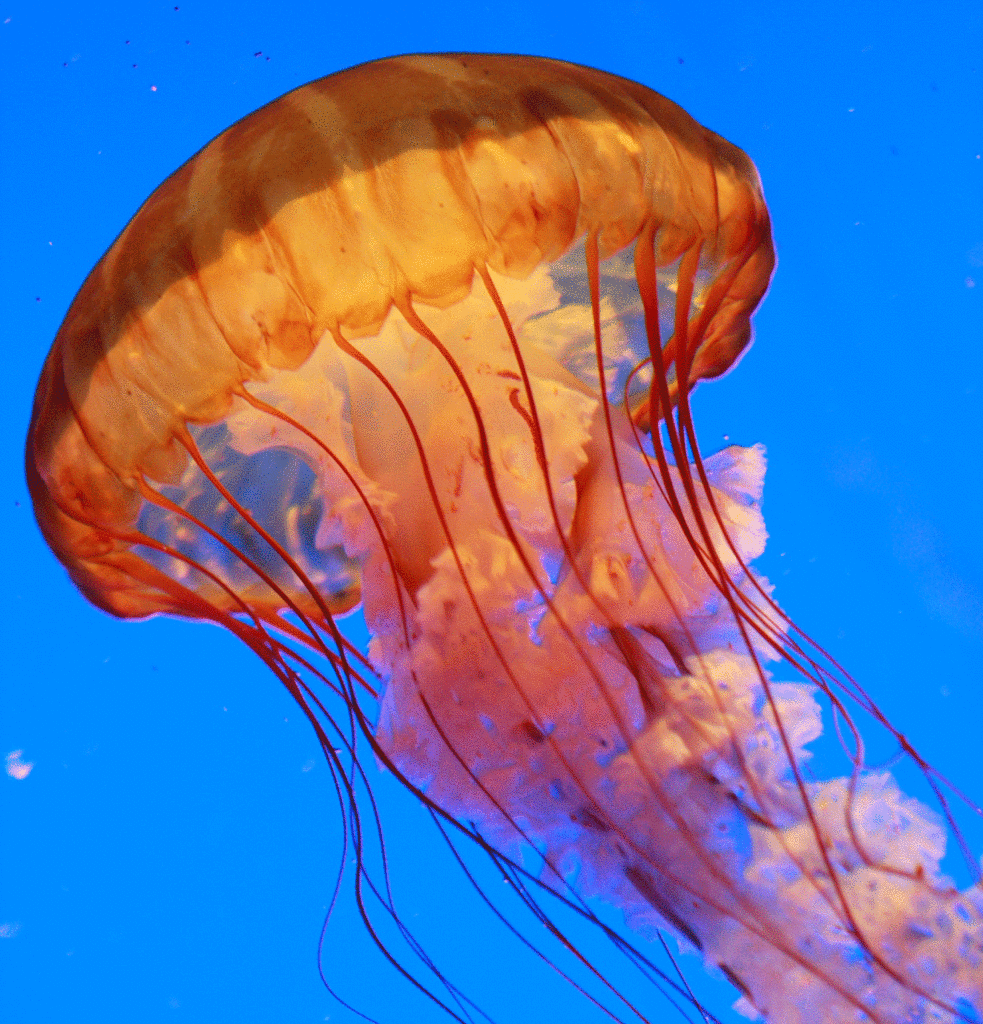P. Pilgrim
Jellyfish drift along the sea on ocean currents and are abundant in cold and warm ocean water, in deep water, and along coastlines, they are found in all the seas throughout the world. The word jellyfish is used to describe animals that are made up of a jelly-like material. So, despite their name, jellyfish aren’t actually fish—they’re invertebrates, or animals with no backbones. They are very simple organisms. The main feature of a true jellyfish is the umbrella-shaped bell. This is a hollow structure consisting of a mass of transparent jelly-like matter known as mesoglea, which forms the hydrostatic skeleton of the animal. 95% or more of the mesoglea consists of water, but it also contains collagen and other fibrous proteins. On the underside of the bell is the manubrium, a stalk-like structure hanging down from the centre, with a small opening from where it both eats and absorbs nutrients and discards waste. There are often four oral arms connected to the manubrium, streaming away into the water below. Around the edge of the manubrium are the stinging tentacles, they are used to inject toxins or poison into their prey which stuns or paralyzes them, before gobbling them up. Although these magnificent marine creatures don’t purposely attack humans, most stings occur when people accidentally touch a jellyfish which can be so small it is almost invisible, while others are as big as humans. The type called Lion’s Mane can grow up to two meters wide and have tentacles as long as 36 meters! Although some smaller species of jellyfish only live for a few hours, larger species like lion’s mane can live for a few years, so relatively speaking they have a short lifespan. Some jellyfish are clear, but others are vibrant colour of pink, yellow, blue and purple. They can be bioluminescent, too, which means they produce their own light! Jellyfish have no brain, heart, bones and only some have eyes like the Box jellyfish, they have a sensory structure called rhopalia were the eyes are located. Their visual systems can be composed of simple eyes or even complex lens eyes, similar to humans. Jellyfish are actually plankton, as the Greek word ‘planktos’ means to wander or drift. The opening at the centre of the body serves another purpose too, as by squirting a jet of water from its mouth, the jellyfish can propel itself forward! However, they are very weak swimmers, so they tend to drift with the tide.
Many people in society are like the jellyfish and just drift along with the habits and thinking’s of the world. They live to please themselves and are able to fit easily into the world around them. Many prefer to copy others about them and be the same as the neighbours. They think the same ideas and don’t want to be seen as different, they are happy to drift along with the rest of humanity. Whereas people who believe in Jesus Christ should be different, they have to swim against the current of what other people think or do. In the gospel of Mathew chapter 16 verse 24 says, ‘Then said Jesus unto his disciples, If any man will come after me, let him deny himself, and take up his cross, and follow me.’ Taking up our cross means obeying God rather than ourselves or our friends. It means being willing to be laughed at when our loyalty to Jesus will not allow us to do the sinful things others may want us to do. A Christian cannot be like a jellyfish; he often has to swim hard against the tide.
pilgrimway101@yahoo.com




